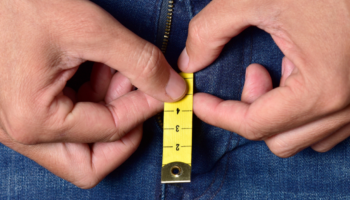Finding it hard to pee despite feeling like you have to go? If you're a man or assigned male at birth (AMAB), an enlarged prostate might be the culprit. Benign prostatic hyperplasia, BPH for short, occurs when the prostate grows too large and pushes on the urethra, leading to some not-so-fun bathroom trips.

Enlarged Prostate: Symptoms, Causes, Treatments, and When to See a Doctor
This article covers everything you need to know about BPH, including the causes, what it feels like, and how to get a proper diagnosis and treatment.
What is Benign Prostatic Hyperplasia (BPH)?
The prostate is part of the male reproductive system and helps with making and releasing semen. It’s located just below the bladder and has a tube called the prostatic urethra that lets urine flow from the bladder to the urethra.
As men and AMAB folks get older, it’s normal for the prostate to change size. It grows once during puberty and then continues to grow slowly after age 25. Sometimes, it grows larger than normal, causing benign prostatic hyperplasia (BPH). When the prostate gets too big, it can press on this tube and make peeing pretty uncomfortable.
To get a better understanding of BPH, Otis W. Brawley, MD, the professor of oncology at Johns Hopkins University, says to think of your prostate as a doughnut.
“The prostatic urethra is the doughnut hole,” he says. “As it rises, the hole in the middle gets smaller. As the prostate gets bigger, it becomes harder and harder for the man to urinate as the prostate strangles down on the prostatic urethra, the tube that carries urine out.”
If you think you have BPH, know that it’s fairly common, affecting over 25% of men aged 65 and older. However, it can be a pain (literally), cause some pesky symptoms, and it can definitely hinder your day to day life.
It’s important to get a proper diagnosis and treatment so you can get back to feeling your best!
Causes and Risk Factors for an Enlarged Prostate
So, what exactly causes the prostate to grow bigger than it's supposed to be? There’s no one answer, but experts agree that the main reasons behind an enlarged prostate are hormonal changes, aging, and genetics.
Hormonal Changes
Aging comes with its fair share of changes, and hormonal shifts are no exception. For men and other people with penises, it usually means less testosterone and more estrogen. This hormonal shift can cause inflammation and growth of certain cells in the prostate, potentially leading to BPH.
A hormone called dihydrotestosterone (DHT) also has a role to play. According to research, DHT makes cells multiple within the prostate, which can cause the prostate to swell and bring on BPH symptoms.
Age
There’s a distinct relationship between BPH and aging, especially as you hit your 60s. After 65, BPH affects one in four people with penises. In other words, the older you get, the more likely you are to develop BPH.
In fact, the biggest risk factor for BPH is age, and this risk only increases the older you get.
“All [people with penises] get some benign prostatic hyperplasia,” Dr. Brawley says. “It starts as they enter their late 40s early 50s. Some [people with penises] get it to the extent that it becomes very difficult to urinate. In others, it is hardly noticeable.”
Family History
Another potential cause of BPH is your family history. Having a family history of BPH is linked to a higher risk of developing BPH. So if your brother or dad had it, you might be more likely to get it, too.
Overall Health
Your overall health plays a role too. Health conditions like diabetes, heart disease, and erectile dysfunction (ED) can increase your risk of BPH. Your family history can also contribute. Eating a healthy diet, exercising regularly, and maintaining a healthy weight may prevent or minimize BPH symptoms.
Symptoms of BPH
Knowing the signs of BPH is important because the condition can be easily dismissed or mistaken as other conditions. Since leaving BPH untreated can lead to some undesirable complications, it's important to identify the symptoms early and seek a professional diagnosis.
The most common BPH symptoms are:
- Trouble starting or stopping urination
- Difficulty emptying bladder
- Weak urine stream
- Peeing more often at night
- Frequent and urgent need to urinate
- Painful urination
Although rare, BPH can also cause:
- Urinary tract infection (UTI)
- Inability to urinate
- Blood in the urine
Prostate size doesn’t really predict how severe your symptoms might be. Some people with swollen prostates don’t have symptoms at all.
That said, BPH symptoms often don’t improve on their own and tend to get worse without treatment. This is because with BPH, the bladder muscles have to work harder to push pee out, wearing them down over time and making it harder to empty the bladder (known as urinary retention). This can lead to UTIs, blood in your urine, bladder stones, and even kidney infections. While rare, kidney infections and UTIs can get dangerous, even deadly.
Diagnosis and Treatment
A healthcare provider can diagnose BPH based on an evaluation, physical exam, and medical testing. Your doctor will ask about your symptoms and medical history. They may perform a digital rectal exam to feel if your prostate is enlarged.
You may also be referred to a urologist for additional testing. These tests may include a prostate-specific antigen (PSA) blood test to measure PSA levels in your blood and a urine flow test to determine the speed and volume of your urine. Your healthcare provider will review your test results to confirm if you have BPH and need treatment.
Treatment Options
Eating a balanced diet, exercising regularly, and staying hydrated are sometimes enough to manage your symptoms. However, enlarged prostate treatment usually requires a combination of alpha blockers, 5-alpha reductase inhibitors (5-ARIs), and phosphodiesterase-5 inhibitors. Alpha blockers and phosphodiesterase-5 inhibitors relax the bladder muscles to make peeing easier while 5-ARIs stop and reverse prostate gland growth.
There are also minimally invasive procedures available to treat BPH, like transurethral water vapor and a prostatic urethral lift. These procedures can shrink enlarged prostate tissue or widen the urethra to improve urine flow.
In severe cases, surgery may be necessary.
“Men with moderate to severe BPH often must resort to a surgery where an instrument is placed up into the urethra to the level of the prostate, and the opening is enlarged mechanically,” Dr. Brawley says. “This is referred to as a transurethral resection of the prostate or TURP.”
Removal of part or all of the prostate can relieve BPH symptoms and prevent them from coming back.
When to See a Doctor
If you experience BPH symptoms, you should see a healthcare provider ASAP. Dr. Brawley recommends seeing a doctor as soon as symptoms appear.
“A [person assigned male at birth] should see a general internist if they are having difficulty urinating,” he says. “This includes difficulty starting a stream, difficulty maintaining the stream, and difficulty emptying the bladder. The general internist will start treatment and may refer the patient to a urologist for more serious BPH.”
Early diagnosis and treatment can help you manage uncomfortable symptoms and prevent complications.
The Bottom Line
BPH is a common but often uncomfortable condition, and it is highly treatable. If you’re experiencing signs of BPH, it’s best to seek medical care.
Your healthcare provider can rule out other conditions and get started with treatment. From lifestyle changes and medication, there are plenty of options to manage your symptoms and improve your quality of life.



